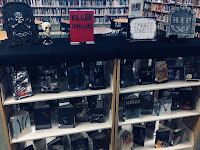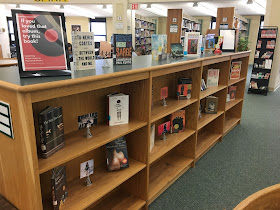I thought creating displays would be the most fun part of my job, but it has proved to be a bit more challenging than I expected. I mean, where do these Pinteresty librarians find the time to be so creative?! What am I supposed to do without any wall space for bulletin boards?! How do I get kids to actually check out the books I put on display?

I kept things simple for my first display of the year with an "around the world" theme. All it took was a globe and some books by international authors. It was fine for August when I was feeling a little overwhelmed by the newness of everything.
Then I read this post from Library Girl, and it changed the way I think about the purpose of displays: "Every display presents us with an opportunity to tackle big things: to address individual student needs, to awaken dormant readers, and to engage all kids in meaningful conversations about books, reading and their lives as learners."
With that in mind, my second display was focused on the fact that ALL my junior high students wanted to read the same books, even though we have hundreds of amazing other choices. So I chose four popular series (The Giver, Hunger Games, Diary of Wimpy Kid, and Harry Potter) and then filled my display shelves with books that have similar themes, characters, and settings. The students kind of ignored it at first, but eventually it was picked over pretty nicely!
 Of course, for Halloween we had to do a scary stories display--but this actually worked out great, because we were getting a lot of requests for scary stories anyway.
Of course, for Halloween we had to do a scary stories display--but this actually worked out great, because we were getting a lot of requests for scary stories anyway.Also in October, we were able to consolidate the fiction section to make room for a more permanent Sports display (another common request), and a New Arrivals shelf. The big readers love being able to see what's new and being the first one to check something out!
 In November, I did a Native American Heritage Month display, but to be honest it was not effective in getting students to actually check those books out. Our school is religiously diverse, so I decided to keep things secular for December. Instead of a holiday theme, I focused on books that have been made into movies. The movie display included a vintage film projector found in my husband's grandparents' basement -- the kids love it! I've also started a book club called "The Book Was Better" and we are reading some of the books from this display.
In November, I did a Native American Heritage Month display, but to be honest it was not effective in getting students to actually check those books out. Our school is religiously diverse, so I decided to keep things secular for December. Instead of a holiday theme, I focused on books that have been made into movies. The movie display included a vintage film projector found in my husband's grandparents' basement -- the kids love it! I've also started a book club called "The Book Was Better" and we are reading some of the books from this display.While I'm still not an expert at this, and I'd still love some wall space, I do feel more confident than before in my display making abilities. For the new year, my goal is to focus on Library Girl's tip #4: build interactive displays. I'll keep you posted!










